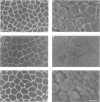Abstract
Abnormalities of dystrophin, the sarcoglycans, and laminin alpha2 are responsible for a subset of the muscular dystrophies. In this study we aim to characterise the nature and frequency of abnormalities of these proteins in an Australian population and to formulate an investigative algorithm to aid in approaching the diagnosis of the muscular dystrophies. To reduce ascertainment bias, biopsies with dystrophic (n=131) and non-dystrophic myopathic (n=71) changes were studied with antibodies to dystrophin, alpha, beta, and gamma sarcoglycan, beta dystroglycan, and laminin alpha2, and results were correlated with clinical phenotype. Abnormalities of dystrophin, the sarcoglycans, or laminin alpha2 were present in 61/131 (47%) dystrophic biopsies and in 0/71 myopathic biopsies, suggesting that immunocytochemical study of dystrophin, the sarcoglycans, and laminin alpha2 may, in general, be restricted to patients with dystrophic biopsies. Two patients with mutations identified in gamma sarcoglycan had abnormal dystrophin (by immunocytochemistry and immunoblot), showing that abnormalities of dystrophin may be a secondary phenomenon. Therefore, biopsies should not be excluded from sarcoglycan analysis on the basis of abnormal dystrophin alone. The diagnostic yield was highest in those with severe, rapidly progressive limb-girdle weakness (92%). Laminin alpha2 deficiency was identified in 5/131 (4%) patients; 215 patients presented after infancy, indicating that abnormalities of laminin alpha2 are not limited to the congenital muscular dystrophy phenotype. Overall patterns of immunocytochemistry and immunoblotting provided a guide to mutation analysis and, on the basis of this study, we have formulated a diagnostic algorithm to guide the investigation of patients with muscular dystrophy.
Full text
PDF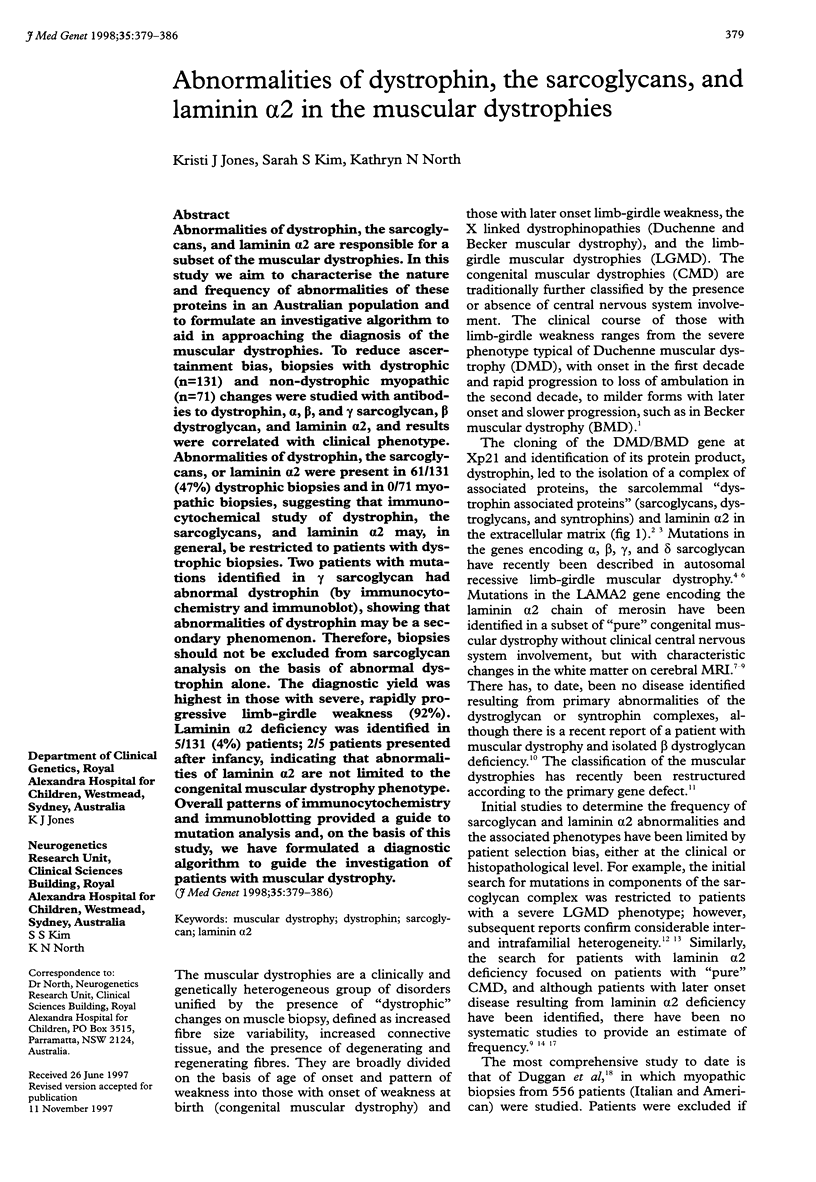
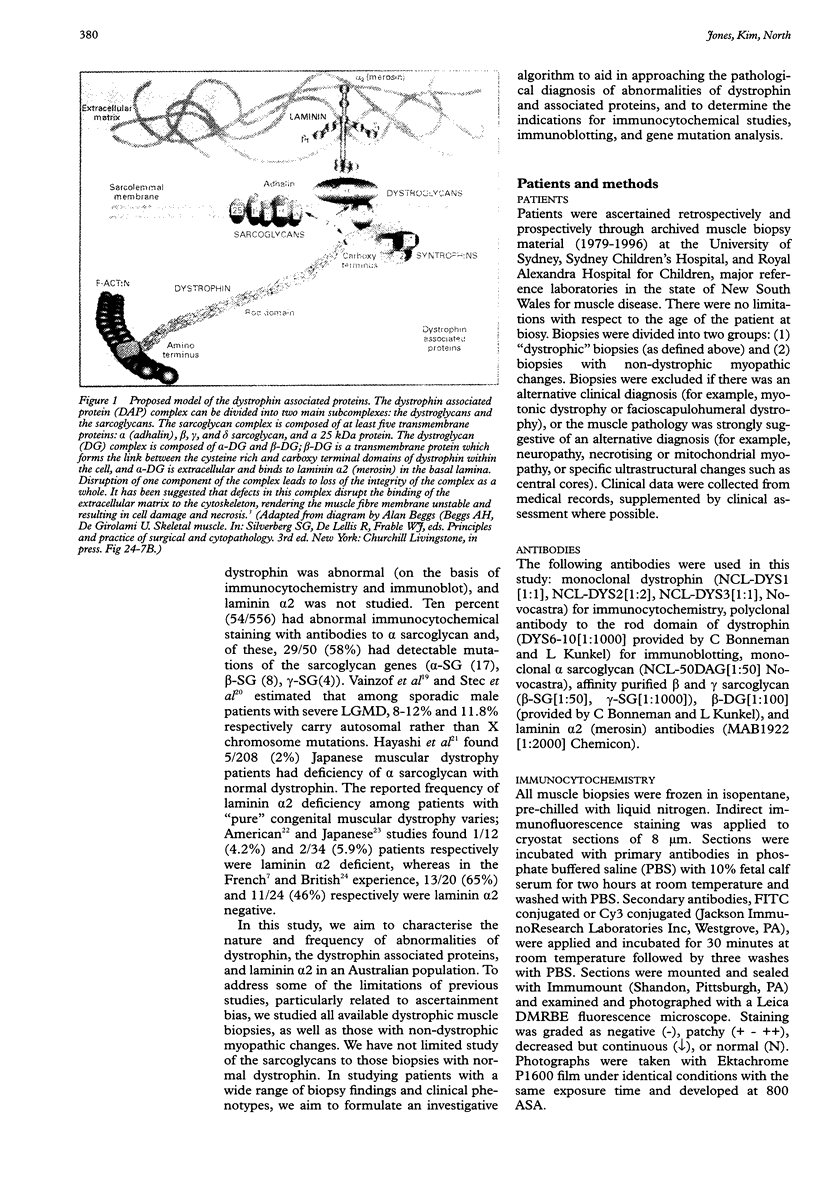

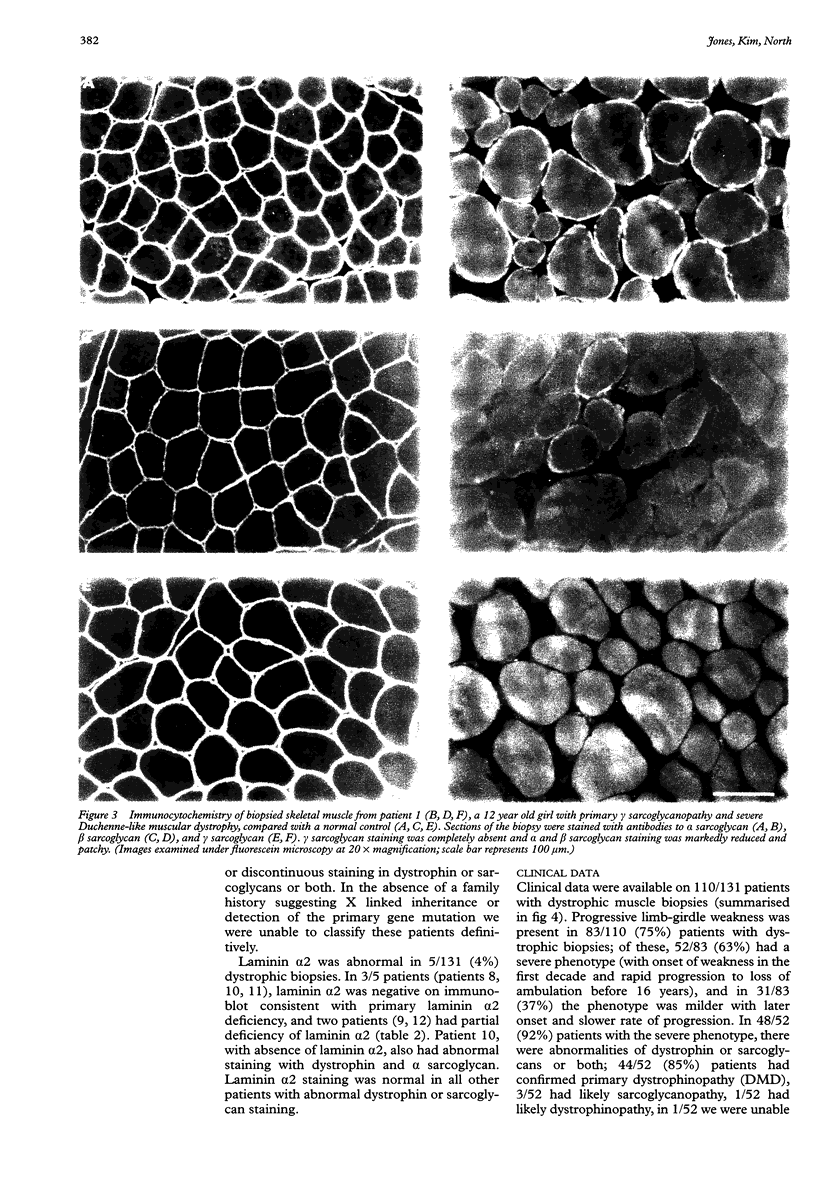
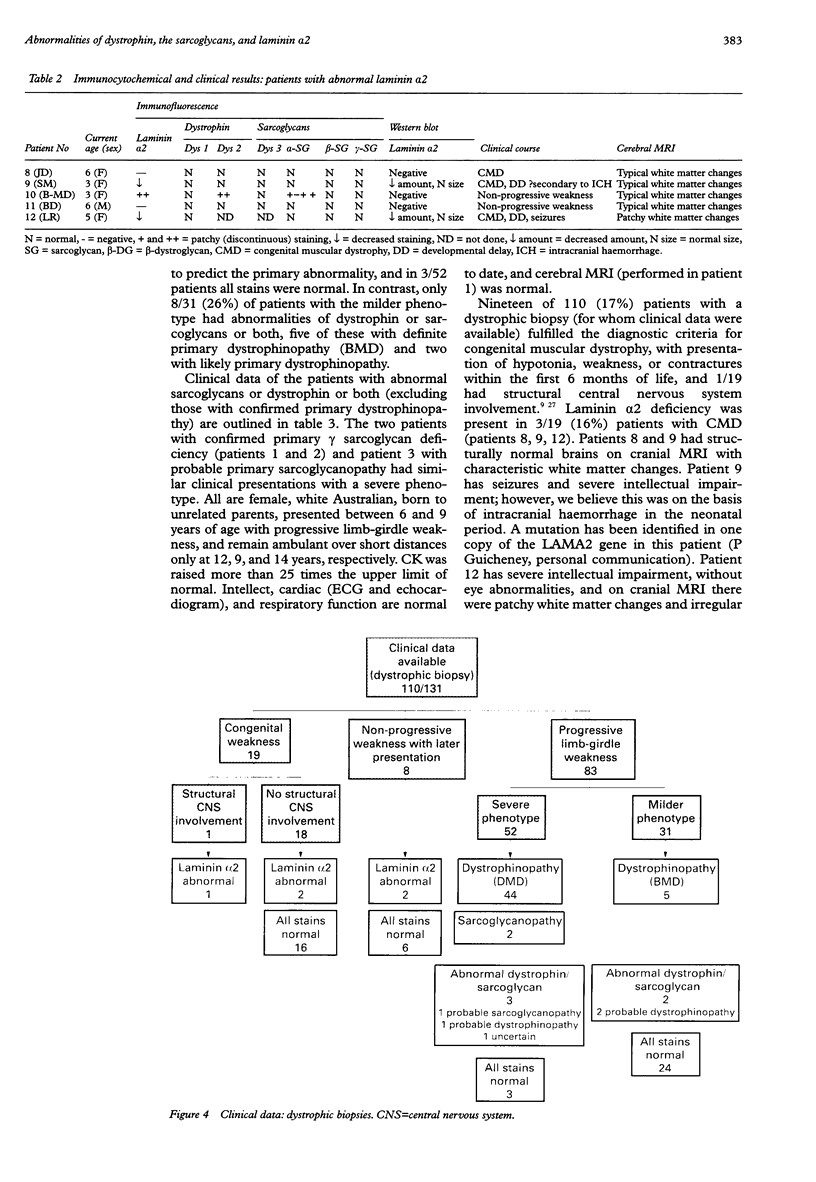

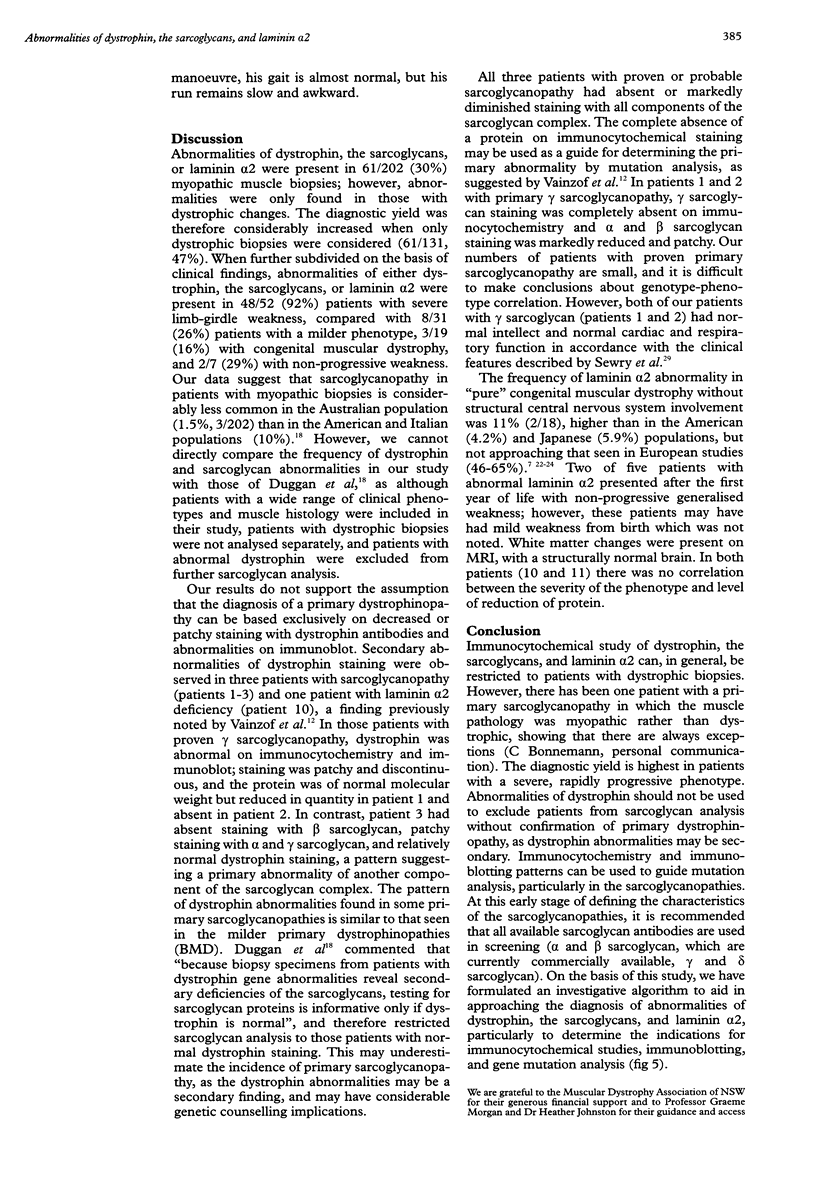
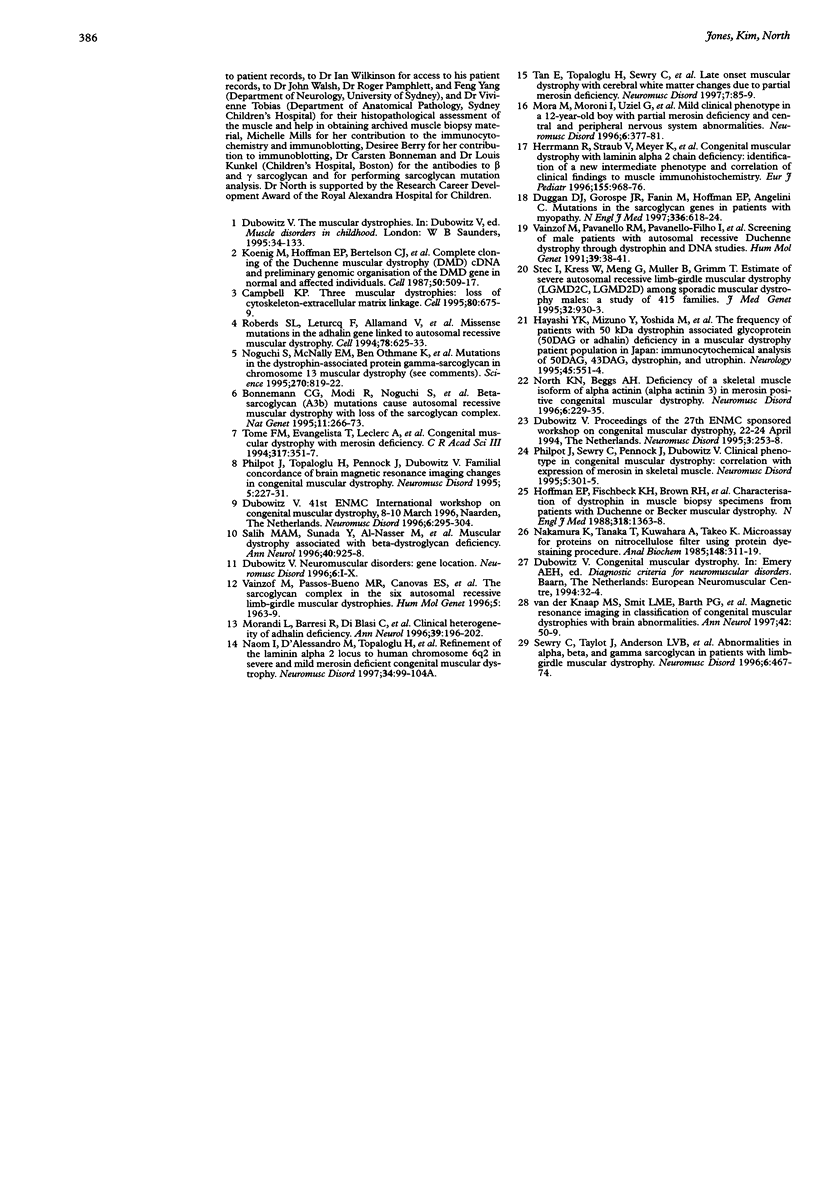
Images in this article
Selected References
These references are in PubMed. This may not be the complete list of references from this article.
- Bönnemann C. G., Modi R., Noguchi S., Mizuno Y., Yoshida M., Gussoni E., McNally E. M., Duggan D. J., Angelini C., Hoffman E. P. Beta-sarcoglycan (A3b) mutations cause autosomal recessive muscular dystrophy with loss of the sarcoglycan complex. Nat Genet. 1995 Nov;11(3):266–273. doi: 10.1038/ng1195-266. [DOI] [PubMed] [Google Scholar]
- Campbell K. P. Three muscular dystrophies: loss of cytoskeleton-extracellular matrix linkage. Cell. 1995 Mar 10;80(5):675–679. doi: 10.1016/0092-8674(95)90344-5. [DOI] [PubMed] [Google Scholar]
- Dubowitz V. 41st ENMC International Workshop on Congenital Muscular Dystrophy 8-10 March 1996, Naarden, The Netherlands. Neuromuscul Disord. 1996 Aug;6(4):295–306. doi: 10.1016/0960-8966(96)00358-6. [DOI] [PubMed] [Google Scholar]
- Dubowitz V., Fardeau M. Proceedings of the 27th ENMC sponsored workshop on congenital muscular dystrophy. 22-24 April 1994, The Netherlands. Neuromuscul Disord. 1995 May;5(3):253–258. doi: 10.1016/0960-8966(95)90011-x. [DOI] [PubMed] [Google Scholar]
- Duggan D. J., Gorospe J. R., Fanin M., Hoffman E. P., Angelini C. Mutations in the sarcoglycan genes in patients with myopathy. N Engl J Med. 1997 Feb 27;336(9):618–624. doi: 10.1056/NEJM199702273360904. [DOI] [PubMed] [Google Scholar]
- Hayashi Y. K., Mizuno Y., Yoshida M., Nonaka I., Ozawa E., Arahata K. The frequency of patients with 50-kd dystrophin-associated glycoprotein (50DAG or adhalin) deficiency in a muscular dystrophy patient population in Japan: immunocytochemical analysis of 50DAG, 43DAG, dystrophin, and utrophin. Neurology. 1995 Mar;45(3 Pt 1):551–554. doi: 10.1212/wnl.45.3.551. [DOI] [PubMed] [Google Scholar]
- Herrmann R., Straub V., Meyer K., Kahn T., Wagner M., Voit T. Congenital muscular dystrophy with laminin alpha 2 chain deficiency: identification of a new intermediate phenotype and correlation of clinical findings to muscle immunohistochemistry. Eur J Pediatr. 1996 Nov;155(11):968–976. doi: 10.1007/BF02282889. [DOI] [PubMed] [Google Scholar]
- Hoffman E. P., Fischbeck K. H., Brown R. H., Johnson M., Medori R., Loike J. D., Harris J. B., Waterston R., Brooke M., Specht L. Characterization of dystrophin in muscle-biopsy specimens from patients with Duchenne's or Becker's muscular dystrophy. N Engl J Med. 1988 May 26;318(21):1363–1368. doi: 10.1056/NEJM198805263182104. [DOI] [PubMed] [Google Scholar]
- Koenig M., Hoffman E. P., Bertelson C. J., Monaco A. P., Feener C., Kunkel L. M. Complete cloning of the Duchenne muscular dystrophy (DMD) cDNA and preliminary genomic organization of the DMD gene in normal and affected individuals. Cell. 1987 Jul 31;50(3):509–517. doi: 10.1016/0092-8674(87)90504-6. [DOI] [PubMed] [Google Scholar]
- Mora M., Moroni I., Uziel G., di Blasi C., Barresi R., Farina L., Morandi L. Mild clinical phenotype in a 12-year-old boy with partial merosin deficiency and central and peripheral nervous system abnormalities. Neuromuscul Disord. 1996 Oct;6(5):377–381. doi: 10.1016/0960-8966(96)00359-8. [DOI] [PubMed] [Google Scholar]
- Morandi L., Barresi R., Di Blasi C., Jung D., Sunada Y., Confalonieri V., Dworzak F., Mantegazza R., Antozzi C., Jarre L. Clinical heterogeneity of adhalin deficiency. Ann Neurol. 1996 Feb;39(2):196–202. doi: 10.1002/ana.410390209. [DOI] [PubMed] [Google Scholar]
- Nakamura K., Tanaka T., Kuwahara A., Takeo K. Microassay for proteins on nitrocellulose filter using protein dye-staining procedure. Anal Biochem. 1985 Aug 1;148(2):311–319. doi: 10.1016/0003-2697(85)90234-9. [DOI] [PubMed] [Google Scholar]
- Naom I. S., D'Alessandro M., Topaloglu H., Sewry C., Ferlini A., Helbling-Leclerc A., Guicheney P., Weissenbach J., Schwartz K., Bushby K. Refinement of the laminin alpha2 chain locus to human chromosome 6q2 in severe and mild merosin deficient congenital muscular dystrophy. J Med Genet. 1997 Feb;34(2):99–104. doi: 10.1136/jmg.34.2.99. [DOI] [PMC free article] [PubMed] [Google Scholar]
- Noguchi S., McNally E. M., Ben Othmane K., Hagiwara Y., Mizuno Y., Yoshida M., Yamamoto H., Bönnemann C. G., Gussoni E., Denton P. H. Mutations in the dystrophin-associated protein gamma-sarcoglycan in chromosome 13 muscular dystrophy. Science. 1995 Nov 3;270(5237):819–822. doi: 10.1126/science.270.5237.819. [DOI] [PubMed] [Google Scholar]
- North K. N., Beggs A. H. Deficiency of a skeletal muscle isoform of alpha-actinin (alpha-actinin-3) in merosin-positive congenital muscular dystrophy. Neuromuscul Disord. 1996 Aug;6(4):229–235. doi: 10.1016/0960-8966(96)00361-6. [DOI] [PubMed] [Google Scholar]
- Philpot J., Sewry C., Pennock J., Dubowitz V. Clinical phenotype in congenital muscular dystrophy: correlation with expression of merosin in skeletal muscle. Neuromuscul Disord. 1995 Jul;5(4):301–305. doi: 10.1016/0960-8966(94)00069-l. [DOI] [PubMed] [Google Scholar]
- Philpot J., Topaloglu H., Pennock J., Dubowitz V. Familial concordance of brain magnetic resonance imaging changes in congenital muscular dystrophy. Neuromuscul Disord. 1995 May;5(3):227–231. doi: 10.1016/0960-8966(94)00047-d. [DOI] [PubMed] [Google Scholar]
- Roberds S. L., Leturcq F., Allamand V., Piccolo F., Jeanpierre M., Anderson R. D., Lim L. E., Lee J. C., Tomé F. M., Romero N. B. Missense mutations in the adhalin gene linked to autosomal recessive muscular dystrophy. Cell. 1994 Aug 26;78(4):625–633. doi: 10.1016/0092-8674(94)90527-4. [DOI] [PubMed] [Google Scholar]
- Salih M. A., Sunada Y., Al-Nasser M., Ozo C. O., Al-Turaiki M. H., Akbar M., Campbell K. P. Muscular dystrophy associated with beta-Dystroglycan deficiency. Ann Neurol. 1996 Dec;40(6):925–928. doi: 10.1002/ana.410400617. [DOI] [PubMed] [Google Scholar]
- Sewry C. A., Taylor J., Anderson L. V., Ozawa E., Pogue R., Piccolo F., Bushby K., Dubowitz V., Muntoni F. Abnormalities in alpha-, beta- and gamma-sarcoglycan in patients with limb-girdle muscular dystrophy. Neuromuscul Disord. 1996 Dec;6(6):467–474. doi: 10.1016/s0960-8966(96)00389-6. [DOI] [PubMed] [Google Scholar]
- Stec I., Kress W., Meng G., Müller B., Müller C. R., Grimm T. Estimate of severe autosomal recessive limb-girdle muscular dystrophy (LGMD2C, LGMD2D) among sporadic muscular dystrophy males: a study of 415 familes. J Med Genet. 1995 Dec;32(12):930–933. doi: 10.1136/jmg.32.12.930. [DOI] [PMC free article] [PubMed] [Google Scholar]
- Tan E., Topaloglu H., Sewry C., Zorlu Y., Naom I., Erdem S., D'Alessandro M., Muntoni F., Dubowitz V. Late onset muscular dystrophy with cerebral white matter changes due to partial merosin deficiency. Neuromuscul Disord. 1997 Mar;7(2):85–89. doi: 10.1016/s0960-8966(96)00421-x. [DOI] [PubMed] [Google Scholar]
- Tomé F. M., Evangelista T., Leclerc A., Sunada Y., Manole E., Estournet B., Barois A., Campbell K. P., Fardeau M. Congenital muscular dystrophy with merosin deficiency. C R Acad Sci III. 1994 Apr;317(4):351–357. [PubMed] [Google Scholar]
- Vainzof M., Passos-Bueno M. R., Canovas M., Moreira E. S., Pavanello R. C., Marie S. K., Anderson L. V., Bonnemann C. G., McNally E. M., Nigro V. The sarcoglycan complex in the six autosomal recessive limb-girdle muscular dystrophies. Hum Mol Genet. 1996 Dec;5(12):1963–1969. doi: 10.1093/hmg/5.12.1963. [DOI] [PubMed] [Google Scholar]
- Vainzof M., Pavanello R. C., Pavanello-Filho I., Rapaport D., Passos-Bueno M. R., Zubrzycka-Gaarn E. E., Bulman D. E., Zatz M. Screening of male patients with autosomal recessive Duchenne dystrophy through dystrophin and DNA studies. Am J Med Genet. 1991 Apr 1;39(1):38–41. doi: 10.1002/ajmg.1320390110. [DOI] [PubMed] [Google Scholar]
- van der Knaap M. S., Smit L. M., Barth P. G., Catsman-Berrevoets C. E., Brouwer O. F., Begeer J. H., de Coo I. F., Valk J. Magnetic resonance imaging in classification of congenital muscular dystrophies with brain abnormalities. Ann Neurol. 1997 Jul;42(1):50–59. doi: 10.1002/ana.410420110. [DOI] [PubMed] [Google Scholar]





